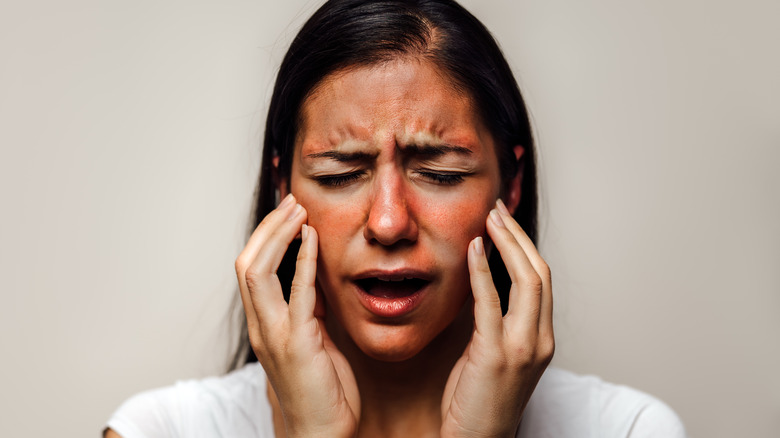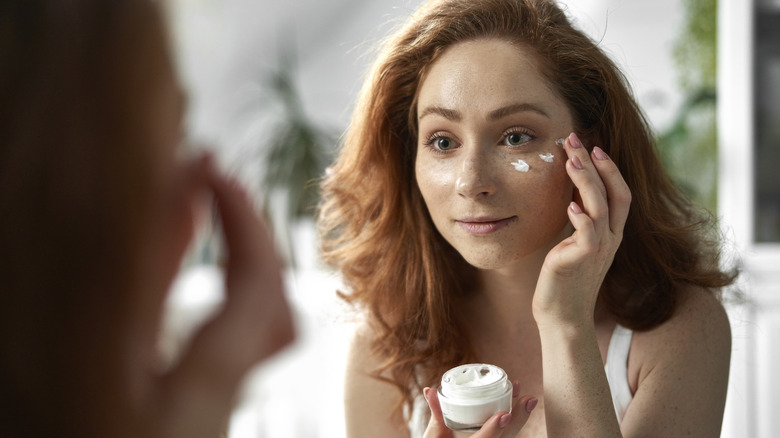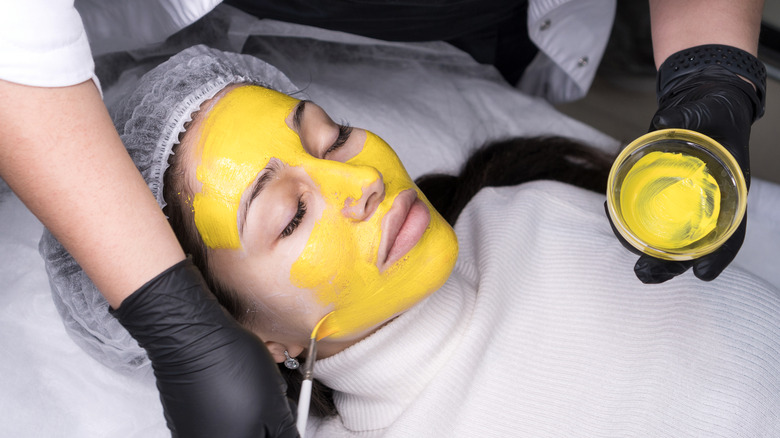How To Fix A Burn From An At-Home Chemical Peel (And When To See A Doctor)
Skincare products are increasingly becoming more accessible. Several treatments that were once reserved for the dermatologist's office now have pretty impressive DIY substitutes. While this makes them more affordable and convenient for many, it also brings the risk of skin damage due to improper technique. One such treatment with the potential for both great results and severe damage is the at-home chemical peel.
There are several different types of chemical peels. Each one differs in concentration, the type of acid used, and the skin type for which it's most beneficial. Speaking to Well+Good, esthetician Inna Knyazevych explained the primary benefits of a chemical peel: "Chemical exfoliation stimulates cellular turnover rate, bringing younger cells to the surface and improving skin's barrier function."
Thus, "It treats fine lines and wrinkles, hyperpigmentation, and acne scarring, and can even help to boost hydration levels of the skin." Of course, you won't get the same results as a dermatologist. And if you're playing with chemicals, you might just get burnt. Burns are a common problem caused by improper usage that, if they aren't handled correctly, can damage your skin via hyperpigmentation, scarring, and infection.
The right way to deal with an at-home chemical peel burn
If you're dealing with a burn right after your chemical peel, you should rinse your face with cold water for a few minutes to get it off as quickly as possible. Gently pat dry afterward. Although chemical peel burns can be quite irritating, you must resist the temptation to scratch because that'll just create more problems in the long run. To soothe any irritation, apply a cold compress to your face.
Next, cut out any non-essential beauty or skincare products from your daily routine. Instead, keep your skin well-hydrated by applying a gentle moisturizer two to three times a day. You can also use naturally hydrating products like aloe vera gel, shea butter, glycerin, and petroleum jelly. Also, drink adequate amounts of water to nourish your cells. After consulting with a professional, you can also apply a topical treatment formulated for healing burns and soothing the skin.
Regardless of whether you're stepping out of the house for a short or long time, be sure to apply sunscreen with SPF50 to prevent further damage caused by UVA rays. You also need to keep the area clean to prevent infections, and the best way to do that would be to use a gentle cleanser twice a day. Don't overwash your face to prevent irritation. Keep a close eye on your burn to ensure it's not getting worse.
How you can better protect yourself from future mishaps
Before you try any home remedies, it's important to assess how the burn looks and the level of pain you're experiencing from it. With mild cases, you'll typically experience itchiness, some irritation, and slight redness. In more serious cases, you will be in a blistering and considerable amount of pain. If you fall in the latter category, your best course of action would be to visit a doctor and let them handle things from there. To prevent this from becoming a recurring problem, do a patch test well beforehand to ensure the peel is a good fit for your skin.
Even if your face seems fine, you don't want to go overboard and use it too often. As consultant dermatologist Dr. Anjali Mahto advised Refinery29, "For anyone looking to incorporate over-the-counter acids into their skin-care routine, start off cautiously, especially if there is a history of sensitive skin. Maybe start using the products a few times a week and slowly build up to see the chemical exfoliation benefits."
If you're just starting your journey using skincare acids, don't get the strongest one in the hopes of achieving better results. Instead, go for the peels with the lowest concentration to lessen the chances of a burn. Remember, less is always more with at-home chemical peels. You also don't want to keep the peel on any longer than instructed because that's one of the biggest causes of burns.


